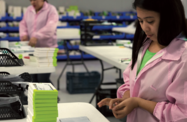The Philippines government is hoping that higher levels of investment and better weather will come to the aid of the agricultural industry as the sector tries to compete with other segments of the economy.
Agriculture remains an important pillar of the Philippines’ economy. It contributes around one-fifth of gross domestic product (GDP) and is one of the largest employers. However, much of the sector’s infrastructure is aging and the logistics chain needed to bring goods from the fields to the marketplace is unable to keep pace with growing demand.
On November 20, Proceso Alcala, the secretary for the Department of Agriculture, announced that the government was developing 17 public-private partnership (PPP) projects with a combined budget of some $2.5bn, to be implemented over the coming six years, with the aim of raising production levels and increasing farmers’ income. The ambitious scheme is hoped to rejuvenate the sector.
The main focus of the programme will be bolstering post-harvest and irrigation infrastructure, along with strengthening marketing facilities, said Alcala.
Eight of the projects – those with the biggest budgets – involve irrigation schemes, some of which will also include a power-generation component. Combined, the eight projects represent almost 80% of the total projected outlays, perhaps a reflection of the crop losses suffered in the past as a result of drought.
Among the other projects set out by Alcala were plans to improve logistics facilities for storing, handling and transporting produce, and an investment of some $50m to assist in developing the production of organic rice, including support for 10,000 ha of dedicated organic rice fields.
Alcala said he was confident there would be strong interest by private investors in the planned projects, based on the results of preliminary discussions.
“We have had initial talks with a number of investors for our PPP proposals. We don’t have details to disclose yet since we are still in the early stages of discussion but with so much interest in the projects, we hope we can put together some more proposals,” the secretary said.
The announcement of the planned increase in investments in the sector comes as the Philippines economy shows signs of slowing, the cooling coming in no small part as a result of the weakening performance of the agriculture industry.
On November 25, the National Statistical Coordination Board released figures showing the country’s economic growth rate has eased in the third quarter, with GDP increasing by 6.5% from a year earlier, compared to the 8.2% rise as of the end of June.
Along with a reduction in state spending, it was a decline in returns from the agricultural sector that put the brakes on GDP growth, according to analysts. The full extent of this deceleration had already been revealed by data issued by the Department of Agriculture in mid-November, which showed that the impact of drought conditions in many regions across the country has cut into crop outputs.
Production fell in the first three quarters by 7.2% year-on-year, with essential grain crops corn and barley dropping by 15.4 and 14.9%, respectively. Though officials have said the Philippines will not need to resort to imports for most of its staples, a further poor season could put greater pressure on the state to ensure basic requirements can be met while also adding fuel to inflationary fires.
The Department of Agriculture’s plans to boost rice production are timely, given the widening gap between domestic supply and demand. Rice production has also been hit by the drought and storms, with the 2010 harvest expected to be around 16m tonnes, down from the 16.24m forecast earlier in the year, despite state and private efforts to boost output.
Already the world’s largest importer of rice, the Philippines will have to import at least 2.5m tonnes of the grain this year, and is looking to call tenders for imports for 2011.
In order to encourage farmers to plant rice, the government is also looking to extend the tariff support for growers and maintain quotas limiting the amount of rice that can be brought into the country.
Though this is seen as a short-term measure, one aiming to support efforts to make the Philippines self-sufficient in rice, the 40% tariff will have to be backed up with additional investments if more growers are move into rice production and away from other often more lucrative crops.
At least some of this investment should come from the PPP projects, with their focus on irrigation, which should mitigate to some degree the vagaries of the weather and help prime primary production.

